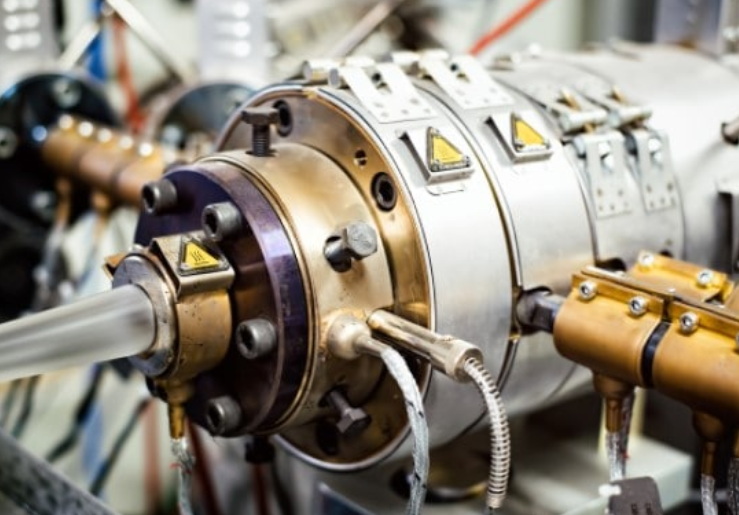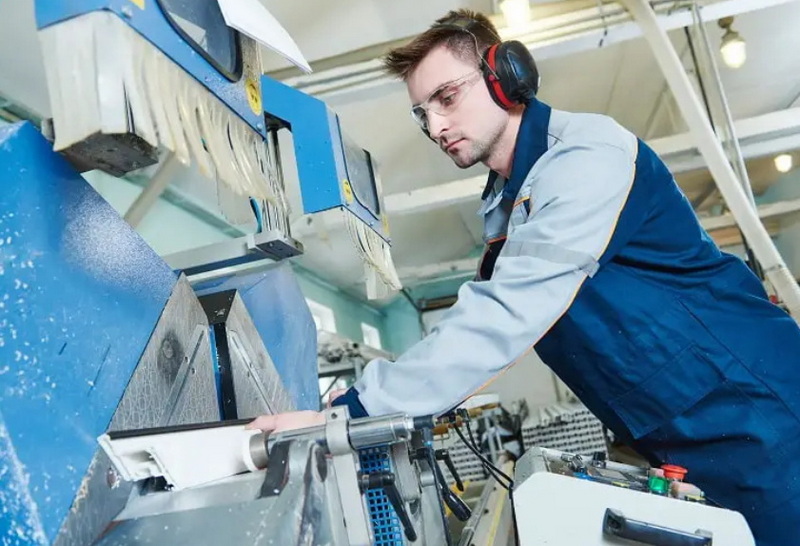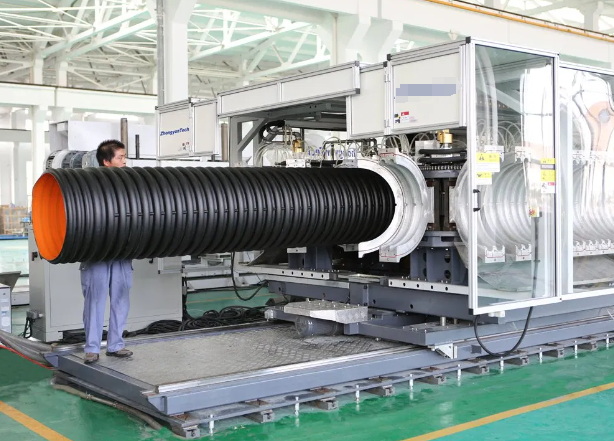Content Menu
● Understanding HDPE Corrugated Pipes
>> Key Characteristics of HDPE Corrugated Pipes
● Components of an HDPE Corrugated Extrusion Production Line
● The Extrusion Process
>> 1. Material Feeding
>> 2. Melting and Mixing
>> 3. Extrusion Through Die Head
>> 4. Calibration
>> 5. Cooling
>> 6. Hauling and Cutting
● Quality Control Measures
● Advantages of HDPE Corrugated Pipes
● Applications of HDPE Corrugated Pipes
● Conclusion
● FAQ
>> 1. What materials are used in HDPE corrugated pipe production?
>> 2. What are the typical applications of HDPE corrugated pipes?
>> 3. How does vacuum calibration work in pipe production?
>> 4. What are the advantages of using HDPE over traditional materials?
>> 5. Can recycled materials be used in HDPE pipe production?
● Citations:
High-Density Polyethylene (HDPE) corrugated pipes are widely used in various applications due to their strength, flexibility, and resistance to chemicals and environmental stress. The production of these pipes involves a sophisticated process known as extrusion, which transforms raw HDPE resin into finished products. This article will explore the workings of an HDPE corrugated extrusion production line in detail, including its components, processes, advantages, and applications.

Understanding HDPE Corrugated Pipes
HDPE corrugated pipes are characterized by their alternating ridges and grooves, which provide enhanced structural integrity and flexibility compared to solid pipes. They are commonly used in drainage systems, culverts, and other applications requiring lightweight yet durable piping solutions.
Key Characteristics of HDPE Corrugated Pipes
- Flexibility: These pipes can bend without breaking, making them ideal for installation in areas with uneven terrain or shifting ground.
- Durability: HDPE pipes have a long service life, often lasting over 50 years, and can function effectively for up to 100 years in suitable conditions.
- Corrosion Resistance: Made from polyethylene, these pipes are highly resistant to corrosion and chemical attacks.
- Lightweight: The reduced weight compared to traditional piping materials makes handling and maneuvering these pipes more manageable.
Components of an HDPE Corrugated Extrusion Production Line
An HDPE corrugated extrusion production line consists of several key components that work together seamlessly to produce high-quality pipes:
- Extruder: The heart of the production line where raw materials are melted and shaped.
- Die Head: Shapes the molten HDPE into a pipe form.
- Calibration Unit: Ensures the pipe maintains the correct dimensions as it cools.
- Cooling System: Cools the pipe to solidify it and maintain its shape.
- Haul-off Unit: Pulls the finished pipe along the production line.
- Cutting Machine: Cuts the pipe into specified lengths.
- Control System: Monitors and controls the entire production process for efficiency and quality assurance.
The Extrusion Process
The extrusion process for producing HDPE corrugated pipes can be broken down into several stages:
1. Material Feeding
The process begins with feeding high-density polyethylene granules into the extruder hopper. These granules are typically a blend of virgin resin and recycled materials to enhance sustainability. The quality of raw materials is crucial as it directly affects the final product's performance.
2. Melting and Mixing
Inside the extruder, the granules are subjected to heat and pressure. The screw mechanism within the extruder rotates, mixing the material while gradually heating it to a temperature between 180°C and 240°C. This step ensures that the HDPE is fully melted and homogenized before being shaped into a pipe. Precise thermal adjustment is critical at this stage since varying temperatures can affect product quality.
3. Extrusion Through Die Head
Once melted, the material is forced through a specially designed die head that shapes it into a continuous pipe form. The die head is crucial for creating the desired wall thickness and profile of the corrugated pipe. The corrugating process occurs under vacuum conditions using rotary dies that create grooves on the outer surface while maintaining a smooth inner surface.
4. Calibration
After exiting the die head, the newly formed pipe enters a calibration unit. This stage uses vacuum calibration to maintain precise dimensions. A vacuum is applied around the outer surface of the pipe, which helps it adhere to a calibration sleeve that defines its final diameter. This step is essential for ensuring that the product meets industry standards for size and strength.
5. Cooling
Following calibration, the pipe is cooled using water sprays or immersion in cooling tanks. This step solidifies the HDPE, ensuring it retains its shape as it moves along the production line. Proper cooling is vital for stabilizing dimensions during production.
6. Hauling and Cutting
The cooled pipe is then pulled by a haul-off unit that moves it forward at a controlled speed. Once it reaches the desired length, a cutting machine slices it into specified sections for packaging or further processing. This stage requires precise timing to ensure consistent lengths across all finished products.

Quality Control Measures
Quality control is an integral part of the production process for HDPE corrugated pipes. Samples from each batch undergo rigorous testing to ensure they meet established standards for strength, flexibility, and durability. Common tests include:
- Compression Strength Testing: Ensures that pipes can withstand external pressures without buckling.
- Hydraulic Testing: Evaluates flow characteristics to ensure efficient drainage performance.
- Dimensional Checks: Verifies that all pipes meet specified measurements for diameter and wall thickness.
Advantages of HDPE Corrugated Pipes
HDPE corrugated pipes offer several advantages over traditional piping materials:
- Lightweight: Easier to handle and install compared to concrete or metal pipes.
- Durable: Resistant to corrosion, chemicals, and environmental stressors.
- Flexible: Can bend without breaking, making them ideal for various applications.
- Cost-effective: Lower installation costs due to reduced labor requirements and transportation expenses.
- Environmental Impact: The use of recycled materials in production contributes to sustainability efforts while maintaining high-quality standards.
Applications of HDPE Corrugated Pipes
HDPE corrugated pipes are versatile and find applications across various industries:
- Municipal Engineering: Used for underground drainage systems, sewage pipes, water supply lines, and ventilation systems in buildings.
- Agriculture: Employed for irrigation systems that conserve water while ensuring efficient drainage in farmland and orchards.
- Industrial Use: Suitable for chemical processing facilities due to their excellent resistance to acids and alkalis.
- Mining Operations: Used as ventilation ducts and drainpipes in mining sites due to their durability under harsh conditions.
- Infrastructure Projects: Commonly utilized in stormwater management systems to prevent flooding in urban areas by efficiently managing runoff water.
Conclusion
The HDPE corrugated extrusion production line is a sophisticated system designed to produce high-quality pipes efficiently. By understanding each component's role in this process—from material feeding to cutting—manufacturers can optimize their operations for better productivity and product quality. The benefits of using HDPE corrugated pipes make them an excellent choice for many applications in construction and infrastructure development due to their durability, flexibility, cost-effectiveness, and environmental friendliness.

FAQ
1. What materials are used in HDPE corrugated pipe production?
HDPE corrugated pipes are primarily made from high-density polyethylene (HDPE) granules, which may include virgin resin and recycled materials for sustainability.
2. What are the typical applications of HDPE corrugated pipes?
These pipes are commonly used in drainage systems, culverts, stormwater management systems, agricultural irrigation systems, and various construction applications due to their strength and flexibility.
3. How does vacuum calibration work in pipe production?
Vacuum calibration involves applying a vacuum around the newly formed pipe as it cools, ensuring that it adheres to a calibration sleeve that defines its final diameter and shape while preventing deformation during cooling.
4. What are the advantages of using HDPE over traditional materials?
HDPE offers several benefits including lightweight handling, corrosion resistance, flexibility, durability, low maintenance costs over time compared to traditional materials like concrete or metal.
5. Can recycled materials be used in HDPE pipe production?
Yes, recycled HDPE materials can be blended with virgin resin during production to enhance sustainability without compromising quality.
Citations:
[1] https://www.parsethylene-kish.com/separsekish/default.aspx?app=Documents&docId=12738&docParId=11470&page=Document
[2] https://www.bausano.com/en/press-and-news/what-is-corrugated-hdpe-pipe-and-its-uses
[3] https://www.tengyuanpipes.com/industry-dynamics/application-hdpe-corrugated-pipe.html
[4] https://provprocure.com/hdpe-pipe-a-complete-guide/
[5] https://www.parsethylene-kish.com/separsekish/default.aspx?app=documents&docid=11522&page=document
[6] https://sinopipefactory.com/blog/hdpe-double-wall-corrugated-pipe-vs-pvc/
[7] https://tdrpipe.com/hdpe-corrugated-pipe-benefits-and-applications/
[8] https://www.youtube.com/watch?v=_aKDo8NtZCw
[9] https://www.youtube.com/watch?v=chWiwgMwvhc
[10] https://www.eiffeltrading.com/blog/post/what-is-corrugated-hdpe-pipe
[11] https://www.youtube.com/watch?v=i7bZx0M4XjY
[12] https://www.linkedin.com/pulse/performance-advantages-hdpe-double-wall-corrugated-pipe-anna-wang
[13] https://plasticpipe.org/common/Uploaded%20files/1-PPI/Manuals-Design%20Guides/Drainage%20Handbook/1st%20Edition/Chapter%204_Application%20Chapter_Final.pdf
[14] https://www.phsinc.com/news/make-corrugated-polyethylene-pipe/
[15] https://www.youtube.com/watch?v=WCznCpciRKw
[16] https://en.lesso.com/blogs/advantages-of-using-corrugated-high-density-polyethylene-pipe-for-municipal-infrastructure-projects/
[17] https://www.pe100plus.com/PPCA/Engineering-and-testing-requirements-for-infrastructure-pipeline-applications-utilizing-HDPE-recycled-materials-p1716.html
[18] https://www.youtube.com/watch?v=ZuSURMaMvOE
[19] https://qdcuishi.en.made-in-china.com/product/eFqGCINVksrx/China-Plastic-HDPE-Corrugated-Pipe-Production-Line.html
[20] https://www.sincopipe.com/resources/benefits-of-using-hdpe-pipes-in-various-applications.html
[21] https://www.bausano.com/img/img_uploaded/webp/c2Use_of_corrugated_hdpe_products_(1)_5f1175c41a46b.jpeg?sa=X&ved=2ahUKEwiA7fiKp-2KAxUWEVkFHcacLcgQ_B16BAgOEAI
[22] https://www.youtube.com/watch?v=h6So-UPZkYQ
[23] https://m.plasticextrusion-lines.com/sale-10414178d-pe-hdpe-corrugated-plastic-pipe-extrusion-line-plastic-double-wall-corrugated-pipe-extrusion-process.html
[24] https://usfusion.com/blog/the-advantages-of-double-wall-hdpe-pipe-systems/
[25] https://sino-tech.en.made-in-china.com/product/LKzQrucPXFVX/China-HDPE-PP-PVC-Plastic-Flexible-Corrugated-Pipe-Extrusion-Production-Line.html
[26] https://www.zhongyuntech.com/trend-of-corrugated-pipe-production-54
[27] https://outsideplantcabling.com/applications-for-corrugated-hdpe-drainage-pipe/
[28] https://www.youtube.com/watch?v=xveZQxzURaY






















